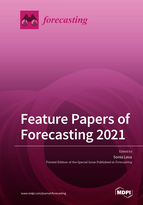Feature Papers of Forecasting 2021
A special issue of Forecasting (ISSN 2571-9394).
Deadline for manuscript submissions: closed (31 December 2021) | Viewed by 53397
Special Issue Editor
Interests: photovoltaic system; grid; power sharing; inverters; forecasting; nowcasting; machine learning; degradation; battery management systems; polymer solar cells; organic photovoltaics; electric vehicle; vehicle-to-grid; microgrid; energy systems; maximum power point trackers; electric power plant loads; electricity price; power markets; heterogeneous networks; base stations; energy efficiency; life cycle assessment; wind power; regenerative braking; bicycles; motorcycles; car sharing; autonomous vehicles
Special Issues, Collections and Topics in MDPI journals
Special Issue Information
Dear Colleagues,
As Editor-in-Chief of Forecasting, I am glad to announce the Special Issue "Feature Papers of Forecasting 2021". This Special Issue is designed to publish high-quality papers in Forecasting. We welcome submissions from Editorial Board Members and outstanding scholars invited by the Editorial Board and the Editorial Office. The scope of this Special Issue includes, but is not limited to, the following topics: power and energy forecasting; forecasting in economics and management; forecasting in computer science; weather and forecasting; and environmental forecasting.
We will select 10–20 papers in 2021 from excellent scholars around the world to publish for free for the benefit of both authors and readers.
You are welcome to send short proposals for submissions of feature papers to our Editorial Office ([email protected]). They will first be evaluated by academic editors, and, then, selected papers will be thoroughly and rigorously peer reviewed.
Prof. Dr. Sonia Leva
Guest Editor
Manuscript Submission Information
Manuscripts should be submitted online at www.mdpi.com by registering and logging in to this website. Once you are registered, click here to go to the submission form. Manuscripts can be submitted until the deadline. All submissions that pass pre-check are peer-reviewed. Accepted papers will be published continuously in the journal (as soon as accepted) and will be listed together on the special issue website. Research articles, review articles as well as short communications are invited. For planned papers, a title and short abstract (about 100 words) can be sent to the Editorial Office for announcement on this website.
Submitted manuscripts should not have been published previously, nor be under consideration for publication elsewhere (except conference proceedings papers). All manuscripts are thoroughly refereed through a single-blind peer-review process. A guide for authors and other relevant information for submission of manuscripts is available on the Instructions for Authors page. Forecasting is an international peer-reviewed open access quarterly journal published by MDPI.
Please visit the Instructions for Authors page before submitting a manuscript. The Article Processing Charge (APC) for publication in this open access journal is 1800 CHF (Swiss Francs). Submitted papers should be well formatted and use good English. Authors may use MDPI's English editing service prior to publication or during author revisions.






